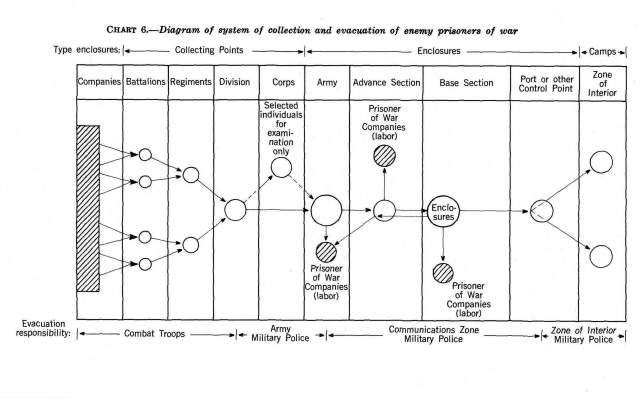This info was taken from :EXTRACT FROM MEDICAL DEPARTMENT, UNITED STATES ARMY, PREVENTIVE MEDICINE IN WORLD WAR II, Volume IX, SPECIAL FIELDS
http://history.amedd.army.mil/booksdocs/wwii/EPWs/EPWs.htm#EUROPEAN THEATER OF OPERATIONS
The system of collection and evacuation of enemy prisoners of war was devised in the planning stage before the United States entered World War II. Modified by experience, it was utilized during the war especially in the European theater. Its essential features are outlined in chart 6.
In the frontline areas, combat troops conducted their captured enemy prisoners of war to regimental and divisional collecting points where they were turned over to Army military police. A few selected prisoners were evacuated from divisional collecting points to a corps prisoner-of-war cage by corps military police and retained, for a time, at corps headquarters for interrogation. The mass of prisoners were taken from divisional collecting points by personnel of Army military police escort guard companies to an Army enclosure. (Or, in 1945, they were also taken to Prisoner of War Transient Enclosures. These transient enclosures are not shown in chart 6, but are indicated in map 8 (p. 384).) At these collecting points, they were processed as thoroughly as possible. Occasionally, prisoners of war were held in these enclosures for several weeks. Evacuation of prisoners from Army enclosures, or from Central Prisoner Of War Enclosures in base sections, to ports in the communications zone, and to ports and camps in the Zone of Interior, was carried out in part by Army military police and in part by Zone of Interior military police. Movement was by bus, truck, rail, and ship, and occasionally by air, according to the situation.
Large resources in men, materials, and organizations were required to handle the hundreds of thousands of prisoners of war captured by U.S. field armies in North Africa, Italy, and Northwest Europe during the campaigns of 1942-45. The forces needed for this work were drawn from several technical services and from various kinds of tactical units.
Contributors to the custodial and professional contingents included: (1) The Office of The Provost Marshal General and its associated Corps of Military Police, (2) the provost marshals and military police under their control at headquarters and communications zones in theaters or areas and in field armies and army groups, (3) the Medical Department, (4) the Quartermaster Corps, (5) the Transportation Corps, (6) the Corps of Engineers, (7) staffs and troops of headquarters from the highest to the lowest echelon, (8) entire infantry divisions (106th and 88th Infantry Divisions), and (9) many artillery, armored, and infantry detachments. Nearly all provided personnel, both specialized and general. Various military organizations supplied food, water, clothing, railroad cars, buses, trucks, ships, airplanes, tents, barracks, structural materials, and buildings.




